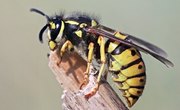
Bumblebees live in colonies made up of mostly female bees. Each colony can have up to 400 bumblebees. The easiest way to tell a female from a male bumblebee is to look at their hind legs and antennae.
Bumblebee Anatomy
A bumblebee's body appears to have only one part because it is covered in long-branched hairs, or setae, that form a fuzzy layer called pile. The body of a bumblebee is actually made up of three sections. The head is at the top, where the eye and antennae are located. The middle section, called the thorax, is where all six legs, the forewings and hindwings are attached. The posterior section is the abdomen, which holds much of the bumblebee's digestive organs and its stinger.
Female Bumblebee Anatomy
Female bumblebees are easily identifiable by looking at their hindlegs, which expand into a smooth convex-shaped structure called a corbicula. The corbicula is where the female bumblebee collects pollen. If a bumblebee has a ball of pollen attached to its hind legs, it is a female.
Female bumblebees generally have little hair on their face, legs and underside of their body. Their antennae are made up of 12 short segments. Their mandibles, outer mouth-parts used to protect their tubular proboscis that sucks up nectar, have a wide, scoop-like shape. They also have a rounded abdomen made up of six segments with a stinger on the end.
Only female bumblebees have stingers. Unlike honey bees, bumblebee stingers lack barbs, so they can sting repeatedly. However, bumblebees generally do not sting unless they are disturbed and handled without care.
Queen and Worker Bumblebees
All queen and worker bumblebees are female. The main difference between queens and workers is their size. Queen bumblebees range in size between 0.59 to one inch. Worker bumblebees range in size between 0.24 to 0.75 inches. In some bumblebee species, the queens and workers have slightly different color patterns.
Both queen and worker bumblebees collect pollen. In early spring, queens emerge to collect pollen and nectar to boost their energy reserves before starting a new nest. After hatching later in spring and throughout summer, the worker bumblebee's job is to collect and bring back food in the form of pollen to help keep the queen and growing colony fed and healthy until late autumn.
Queens live for around a year. Workers and males die before winter. It is only the new, fertilized queens that hibernate through winter.
Female Bumblebees Carrying Pollen
Workers may travel up to a mile away from their nest to collect pollen, traveling at speeds of up to 34 miles per hour. Bumblebees can carry up to 90 percent of their body weight in food back to their nest. The energy it takes them to carry this amount of pollen back to the nest means that at any one time, they are about 40 minutes away from starvation, so they need to feed on the nectar of flowers frequently.
To signal to other bumblebees that a flower is empty, bumblebees leave a chemical footprint on the petals. Each species of flower takes a different amount of time to refill with nectar. When the flower is full again, the chemical footprint left disappears so that another bumblebee can come and feed on it.
Male Bumblebee Anatomy
Male bumblebee antennae are longer than females, with 13 sections. They also have a longer, narrower abdomen than females, made up of seven sections; they also lack a stinger. Their mandibles are thin and bearded with fine hairs. In comparison to females, males often have yellow hairs on their face, legs and underside. Sometimes the males also have enormous eyes.
Bumblebee legs are the easiest way to tell males and females apart. Males' hindlegs are thinner and hairier with a concave shape. Male bumblebees do not collect pollen as the females do.
In late summer, the colony queen produces males and new queens. After hatching, the males leave the nest to mate with new queens from other colonies. They keep their energy up by feeding on the nectar of flowers. Typically, male bumblebees do not return to their colony to live.
References
About the Author
Adrianne Elizabeth is a freelance writer and editor. She has a Bachelor of Science in Ecology and Biodiversity, and Marine Biology from Victoria University of Wellington in New Zealand. Driven by her love and fascination with all animals behavior and care, she also gained a Certificate in Captive Wild Animal Management from UNITEC in Auckland, New Zealand, with work experience at Wellington Zoo. Before becoming a freelance writer, Adrianne worked for many years as a Marine Aquaculture Research Technician with Plant & Food Research in New Zealand. Now Adrianne's freelance writing career focuses on helping people achieve happier, healthier lives by using scientifically proven health and wellness techniques. Adrianne is also focused on helping people better understand ecosystem functions, their importance, and how we can each help to look after them.
